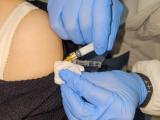Mar 8, 2012 (CIDRAP News) – As part of its effort to shore up the waning supply of effective antimicrobials, the Infectious Diseases Society of America (IDSA) has proposed a streamlined approval pathway for antibiotics intended for special classes of patients who lack other treatment options.
The proposal, called the "Special Population Limited Medical Use" (SPLMU) mechanism, envisions much smaller clinical trials and a faster and less expensive regulatory review than those required for drugs intended for broader use.
In related news, the World Health Organization (WHO) today released a long report on the global threat of antimicrobial resistance (AMR). The report, The Evolving Threat of Antimicrobial Resistance: Options for Action, reviews the battle against AMR since the WHO released a global strategy for dealing with problem in 2001 and discusses areas where knowledge is lacking and where urgent action is needed.
Idea presented at House hearing
The IDSA presented its SPLMU proposal to the House Energy and Commerce Health Subcommittee today at a hearing on reauthorization of the US Food and Drug Administration's (FDA's) Prescription Drug User Fee Act (PDUFA). The bill, which authorizes charging fees to pharmaceutical companies to help cover the cost of reviewing drug license applications, is considered one of the few must-pass bills in Congress this year, the IDSA says.
In a press release, Brad Spellberg, MD, co-chair of the IDSA's Antimicrobial Availability Task Force, called AMR one of the world's greatest health threats and added, "This new mechanism provides the opportunity to address this public health crisis while there is still time to fix it."
The proposed approach "streamlines the approval pathway and enables pharmaceutical companies to study SPLMU drugs in far fewer patients than currently is required, more rapidly, and at significantly less cost—because they are intended for more targeted use within a special population of patients who lack other treatment options," the IDSA statement said.
"SPLMU designation reserves a drug for use in specific populations in which the benefits outweigh the risks, and encourages prudent use of the drug to slow the rate of resistance," it added.
The IDSA is proposing the SPLMU pathway as an addition to pending legislation called the GAIN Act, for Generating Antibiotic Incentives Now. Lawmakers at today's hearing were expected to consider whether to incorporate the GAIN Act in the user-fee bill, the IDSA said.
In a statement submitted to the House subcommittee, the IDSA said that drugs evaluated via the SPLMU pathway "would be narrowly indicated for use in a small, specific population of patients for whom the benefits of the drug have been shown to outweigh the risks." Limiting use in this way would help slow the emergence of resistance, the group said.
"IDSA is aware of at least seven companies with urgently needed antibiotics in their portfolios," and establishing the SPLMU pathway could immediately help them bring the drugs to market, the statement said.
Spellberg told CIDRAP News that it's difficult to be very specific about the pathogens that would be targeted by drugs reviewed under the SPLMU mechanism, since each pathogen may have easily treatable as well as harder-to-treat strains. But in general, organisms such as Acinetobacter, Pseudomonas, and Klebsiella are examples of bacteria that drugs approved through this pathway would treat, he said.
The IDSA likened the SPLMU mechanism to the Orphan Drug Program, but it said FDA officials have indicated that the kinds of anti-infectives intended for the SPLMU pathway do not fit under that program.
The IDSA also said it anticipates that an SPLMU designation targeting a very small population would, like an Orphan Drug designation, "markedly decrease costs of development and simultaneously increase the price of these critically needed new drugs, making investment in their R&D more attractive to pharmaceutical companies."
WHO report covers five areas
The WHO report focuses on five areas that were recognized in the agency's 2001 strategy as crucial for controlling antibiotic resistance: surveillance, rational use in humans, rational use in animals, infection prevention and control, and innovations.
Data on local resistance patterns help providers choose the best treatment for individual patients, but many healthcare facilities have no data on local resistance patterns, the report says. "The lack of adequate surveillance in many parts of the world leaves large gaps in existing knowledge of the distribution and extent of AMR."
On the controversial topics of antimicrobial use in food animals, the WHO says such use "is probably a major contributor to the overall problem o f emerging AMR." In countries making sustained efforts to limit antibiotic use in animals, "AMR prevalence among zoonotic bacteria and indicator bacteria in locally produced meat is lower than in imported products," the report states.
The report also includes a chapter discussing the need for political commitment to the battle against AMR.
See also:
Mar 8 IDSA press release
Information on Mar 8 hearing of House Energy and Commerce Subcommittee on Health
Mar 8 WHO report





















